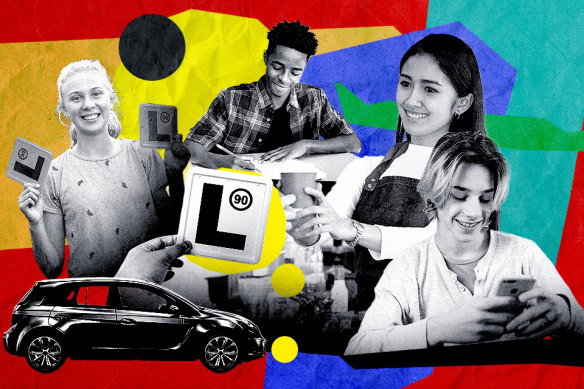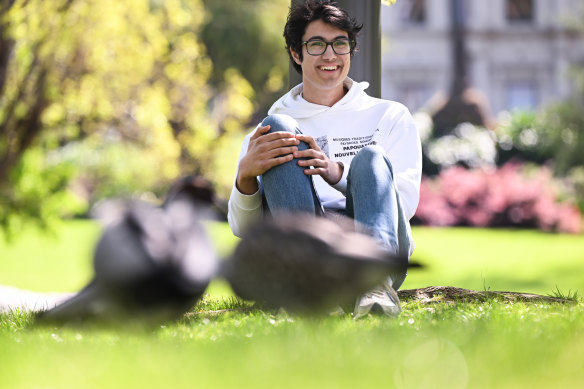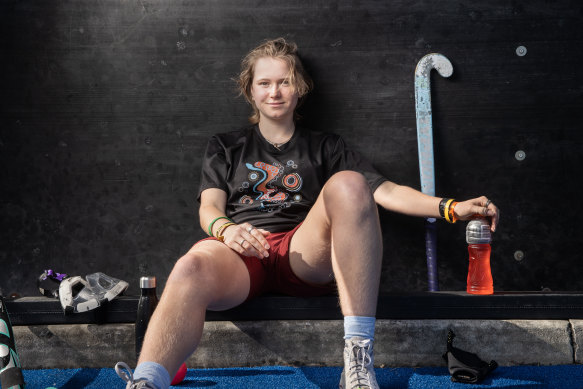This was published 1 year ago
Pandemic scramble: Some lockdown teens are still stuck, while others are thriving
In this series focusing on the wellbeing of pre-schoolers, school and tertiary students, The Age explores what children and young people need to thrive in a post-pandemic world.
By Wendy Tuohy

Many teenagers found freedom to explore interests away from school during the pandemic years.Credit: Illustration: Aresna Villanueva
If it takes a young person to really understand another young person, year 12 student and youth advocate Ravin Desai is well placed to give a window into the minds of his peers.
Teens were thrown sideways by being stuck at home when they should have been bonding and having fun, and two years on from Victoria’s last lockdown, some are thriving, while others are still mentally – and behaviourally – stuck.
Desai, 17, says you need look no further than what’s happening to year 10s to see the impact of losing contact with the world in early adolescence.

Year 12 student Ravin Desai says year 10 students across schools he knows are showing big signs of the historic isolation in their teens.Credit: Joe Armao
Speaking as part of an Age series focusing on the wellbeing of children and young people, to coincide with two years since lockdowns ended, the state youth council advocate describes the year 10 cohort as “the most bizarre”.
This takes the form of “just the level of behaviour issues ... everywhere, it’s terrible”.
“People really didn’t mature, they lost out on year 7 and 8, which are those critical years. At a lot of schools there are behaviour issues [with this group, now aged 15 and 16],” says Desai, who has a sister that age and knows others through his involvement with the Youth Affairs Council of Victoria.
“There is not much respect for authority and just people in general. I think that’s a byproduct of just missing out on those critical years when you get grounded.
“It’s where you make your friends. To lose out on all of that foundation is really sad.”
Some people didn’t mature at all ... we’ve got this huge gap. A lot of friendship groups have split; it’s kind of weird.
Ravin Desai, year 12 student
Despite the increased incidence of mental health issues among young people – whom research has shown to be the worst affected in the COVID era, and who are still suffering at concerning levels – the news is not all bad, Desai says.
Peers found that the freedom to explore interests away from structured school during lockdowns helped them evolve into self-starters with broader experience.
“There’s two camps: one that has done really well from COVID, has matured a lot, that has kind of realised school isn’t the be-all and end-all and has loved the freedom,” he says.
“I’m definitely in that camp. But then there are some people who didn’t mature at all. And it’s like we’ve got this huge gap. A lot of friendship groups have split; it’s kind of weird.”
Parents urged to engage
Parents and schools will receive an in-depth insight into how their young people are faring when research by the Australian Council for Educational Research and Beyond Blue is released later this year.
It will show that while younger age groups are doing relatively fine, the wellbeing of secondary school students is still sliding.
The council’s principal research fellow, Dr Katherine Dix, says the new data shows secondary students still have elevated levels of worry, especially about loss of control.
“With resilience, engagement in school, we see that declining with [student] age in every data set ... in mood particularly in secondary school kids, that’s still going down,” Dix said.
“It should be pretty stable year-on-year, but to see things dropping in hundreds of thousands of kids, it’s pretty clear something’s happening.” Victorian students are more anxious about COVID than those in other states, she said.
The study will also show that absenteeism is worsening, to the point where “[education] departments are concerned”.
Schools are doing their best, but Dix urged parents to attend information evenings to stay in touch with students’ wellbeing.
Making the most of it
Year 12 student Louis Janssen agrees with Desai that the lingering impact of lockdowns shows itself in different ways – but both say that for some, the deviation in life course has been positive, if painful.

Louis Janssen became depressed in isolation but then recovered to take a new, highly satisfying education and life path.Credit: Simon Schluter
“I have friends who didn’t return to the classroom during the pandemic at all, and are now struggling socially in the classroom, and other friends who excelled academically and returned quite normally.
“It created a big gap between my peers,” said Janssen, 18.
Some students Janssen knows chose to enter trades, and are happy with their move.
Janssen lived with family in regional Victoria during lockdowns, but being cut off from sports club peers triggered a year’s worth of depression.
Janssen realised the way out was to move to Melbourne to attend a sports-industry feeder school, Seda College, and take a VCE with a vocational major.
“That’s when I started being interested in coaching and sports administration. If it wasn’t for the pandemic, I definitely wouldn’t have gone down that path,” said Janssen.
“It was just disappointing that it took such an impact on my mental health [to promote the move].”
Janssen is already working with several Victorian sports organisations, including VicSport, on its Youth Engagement Strategy.
Year 11s optimistic – and also worried
Janssen’s ability to use lockdown as an eventual turning point is consistent with the 2023 instalment of Melbourne University’s Life Patterns project, which follows the progress of groups of Australian young people from the age of 17.
Research fellow Dr Quentin Maire says members of the latest intake of 10,250 year 11 students, from four states and territories, list mental health as a top concern, but are optimistic.
“We asked, ‘How optimistic do you feel about your own future, Australia’s, and the world’s?’ The majority of young people are telling us, ‘I will be fine, I can find ways to make things work for myself’. There is optimism there,” said Maire.
“When it comes to Australia and the world at large, they are very pessimistic; climate change being a massive one, the broader loss of things is getting the better of having the sense things do improve.”
Interpersonal relationships and discrimination were also standout concerns.
“That is one, more positive thing to come out of [the pandemic], awareness that discrimination is there and inequality matters.”
Another positive was that many young people surveyed said they had become closer to family.
The teens also said they wanted to be able to have space and time to do physical activity, but wanted to not be under too much pressure to do it.
A sticky lockdown legacy
Despite evidence of optimism, Mark McClay, chief executive of the Country Education Partnership, said student Ravin Desai’s observation about post-lockdown behavioral issues was right.
Introverted or self-driven young students were “either doing OK, or thriving” almost two years after they entered the “new normal”. But there was pervasive apathy among a large group.
“Kids who were a little bit apathetic already, or didn’t have supports [at home or school] to be pushed to do things – they’ve fallen right away,” McClay said. “That divide is now huge.”
“I had a school say just last week that the apathy has extended to part-time jobs. If they don’t like it, or ‘the boss looked at me the wrong way’, they’ll stay home because there’s another job just down the road,” he said.
The value of getting a high ATAR score “seems to be diminishing”.
“There’s a definite increase in behaviour issues right now ... of non-attendance and parents who are accepting of that,” McClay said. This is being put down to mental health, but McClay feels apathy has caught on.
The Life Patterns 2023 data found that more than a quarter of male year 11s (28.9 per cent) and more than two in five female year 11s (44.4 per cent) described their mental health as “very unhealthy or unhealthy”.
About one in five girls (22.1 per cent) described themselves as “very healthy” mentally.
Both clinical psychologist Andrew Fuller and developmental neuroscientist Professor Kim Cornish say attention problems and distractibility are hangovers of lockdowns.
Some students feel a sense of hopelessness – “a feeling of, ‘I don’t know what’s important any more’” – says Cornish, who is founding director of Monash University’s Turner Institute for Brain and Mental Health.
Though “we were lucky we haven’t seen a massive downturn in academics”, many secondary students have been left struggling with direction.
“For many of them at [the secondary] end, they don’t know what they want to do, and have no sustained attention,” she said.
Cornish wants mental health literacy introduced in curriculums, and ongoing resourcing for post-pandemic student support, the likes of which was put in place by the Victorian government at the pandemic peak.
Fuller is upbeat, as he sees young people are making their own positives from what they have lived through.
For example, though online gaming addiction has been identified as such a serious issue it is driving some young people out of school, others are using the digital skills they had time to develop to start micro businesses.
“There are more little start-ups, kids giving it [digital businesses] a go. There’s quite a bubble of innovation beginning which is easy to miss, they are doing some good stuff,” he said.
“The adult world does seem to like to attach a problem to young people, but it’s not all doom and gloom.”
If you or anyone you know needs support call Kidshelpline 1800 55 1800, Lifeline 131 114, or Beyond Blue 1300 224 636.
The Morning Edition newsletter is our guide to the day’s most important and interesting stories, analysis and insights. Sign up here.